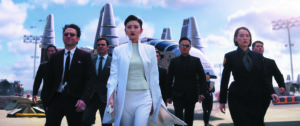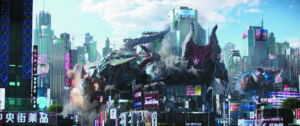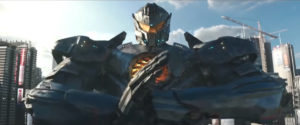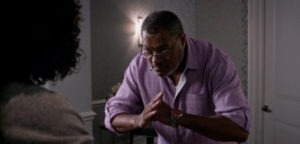By Drs. Craig and Silvia Reid
 As I’m watching the Steven S. DeKnight directed Pacific Rim Uprising (PRU) the Prego spaghetti sauce commercial comes to mind, especially the ad’s subliminal, “It’s in there, ” message in regard to the necessary ingredients in the sauce that makes it authentic. Thus for PRU‘s ingredients, Transformers, Power Rangers and Godzilla inspired monsters, “It’s in there.” Yet the ingredients are no longer for spaghetti but Chinese noodles.
As I’m watching the Steven S. DeKnight directed Pacific Rim Uprising (PRU) the Prego spaghetti sauce commercial comes to mind, especially the ad’s subliminal, “It’s in there, ” message in regard to the necessary ingredients in the sauce that makes it authentic. Thus for PRU‘s ingredients, Transformers, Power Rangers and Godzilla inspired monsters, “It’s in there.” Yet the ingredients are no longer for spaghetti but Chinese noodles.
Due to China’s financial muscle growing by the year and is becoming recognized as a global cinematic power, instead of Chinese film’s making martial arts epics with Western audiences in mind, the shoe is on the other foot as Hollywood is keeping the Chinese market in mind when they make their films.
 Look no further than Daniel Wu’s starring role on Tomb Raider, who in my opinion stole the movie even though they didn’t use him for his strongest casting point…doing really good fight action, which Tomb Raider sorely lacked. Donnie Yen in Rogue One: A Star Wars Story was deemed by the fans as the most popular character and his singular fight was the considered the film’s most memorable one. In PSU, not only is there a strong presence of Chinese actors and Chinese related plot points but also the fight sequences this time around are more inspired by Chinese martial arts than Japanese. And in an ironic sense, China saves Japan.
Look no further than Daniel Wu’s starring role on Tomb Raider, who in my opinion stole the movie even though they didn’t use him for his strongest casting point…doing really good fight action, which Tomb Raider sorely lacked. Donnie Yen in Rogue One: A Star Wars Story was deemed by the fans as the most popular character and his singular fight was the considered the film’s most memorable one. In PSU, not only is there a strong presence of Chinese actors and Chinese related plot points but also the fight sequences this time around are more inspired by Chinese martial arts than Japanese. And in an ironic sense, China saves Japan.
In Pacific Rim there was a global conflict between otherworldly and monsters of the deep destruction called Kaiju and the human-piloted super-machines Jaegers built to quell them. It was a victory at sea for the puny humans, but like any human society, they grow complacent, comfortable and resort to their old ways of greed, disunity and distrust. In PSU, it’s 10 years later and humanity is again on the eve of destruction as the kaijus are a comin’ and this time it’s beyond personal, it’s human-al.
 For those that came in late, kaiju is a Japanese word that means strange beast that are usually correlated with the birth of the Japanese monster movie Godzilla in 1954 that quickly introduced a cache of other kaiju like Rodan, Ghidora and Mothra.
For those that came in late, kaiju is a Japanese word that means strange beast that are usually correlated with the birth of the Japanese monster movie Godzilla in 1954 that quickly introduced a cache of other kaiju like Rodan, Ghidora and Mothra.
 The rebel, disillusioned Jaeger pilot Jake Pentecost (John Boyega), son of the Jaeger pilot that altruistically saved the world by Dante Inferno-ing the kaiju to hell, resigns from the pilot program and lives a life of infamy, until he hooks up with 15-year old street waif Amara, who built her own mini-Jaeger so she never has to live in fear again.
The rebel, disillusioned Jaeger pilot Jake Pentecost (John Boyega), son of the Jaeger pilot that altruistically saved the world by Dante Inferno-ing the kaiju to hell, resigns from the pilot program and lives a life of infamy, until he hooks up with 15-year old street waif Amara, who built her own mini-Jaeger so she never has to live in fear again.
However, PRU had one of it’s champion Jaegers use a Chinese hand expression that in the Chinese martial arts circles is ruder than giving someone the middle finger, a gesture so insulting and disrespectful toward Chinese culture and martial arts history, that it was traditionally tantamount to a fight to the death.
 One day in 1981, when I was learning kung fu in Taiwan, two men approached my sifu, sneered and gave him a kung fu salute that I thought I’d seen tons of times in kung fu films; an open right hand resting against a closed left fist. Sifu reciprocated, then broke one guy’s arm and tossed the other off a 10-foot high balcony onto cement. When I asked sifu what happened, he told me the history behind the kung fu salute.
One day in 1981, when I was learning kung fu in Taiwan, two men approached my sifu, sneered and gave him a kung fu salute that I thought I’d seen tons of times in kung fu films; an open right hand resting against a closed left fist. Sifu reciprocated, then broke one guy’s arm and tossed the other off a 10-foot high balcony onto cement. When I asked sifu what happened, he told me the history behind the kung fu salute.
Originating at the beginning of the Ching Dynasty (1644), the kung fu salute–arms held out in front of you, right fist resting against a left open palm–was used by Ming loyalists as a salute of recognition. When someone reversed the hand position (right open hand against the left fist), it meant he was a Ching loyalist and so a fight to the death would ensue. As I watched kung fu films more carefully, some villains would use the reverse salute to accentuate their contempt toward the heroes.
Over the years, the correct salute has become standard in kung fu schools to represent respect to one’s teacher, each other and globally to fellow kung fu practitioners. Tournament competitors that used the reverse salute would be disqualified. I didn’t notice that the two guys gave my sifu the reverse salute, thus the vicious fight.
 In fact, this slight of wrong hand was used in the highly controversial African American TV show Black-ish by Lawrence Fishburn, who after working with Yuen Woo-ping on The Matrix might surely have known better the connotation of the gesture. When it comes to racism in the United States, ignorance is no longer an excuse for racial slurs or remarks. The show and ABC never returned my calls. Why? Perhaps figuring no one would catch it, they didn’t care or it was a purposeful subliminal cultural jab at something not yet identified?
In fact, this slight of wrong hand was used in the highly controversial African American TV show Black-ish by Lawrence Fishburn, who after working with Yuen Woo-ping on The Matrix might surely have known better the connotation of the gesture. When it comes to racism in the United States, ignorance is no longer an excuse for racial slurs or remarks. The show and ABC never returned my calls. Why? Perhaps figuring no one would catch it, they didn’t care or it was a purposeful subliminal cultural jab at something not yet identified?
The Fights of Pacific Rim Uprising
 One of the design elements director Guillermo del Toro wanted in Pacific Rim was to have the Jaegers exhibit speed without betraying the weight and scale of these 250 feet tall machines and this effect was done by using camera cheats used to slow or speed up their action sequences. For PRU, since the idea that over the 10 year gap in the film’s universe, the machines needed to convey a sense of weightlessness and better agility since more martial arts were going to be incorporated into the fights.
One of the design elements director Guillermo del Toro wanted in Pacific Rim was to have the Jaegers exhibit speed without betraying the weight and scale of these 250 feet tall machines and this effect was done by using camera cheats used to slow or speed up their action sequences. For PRU, since the idea that over the 10 year gap in the film’s universe, the machines needed to convey a sense of weightlessness and better agility since more martial arts were going to be incorporated into the fights.
 Boyega noted that he disliked how the Jaegers moved in the original film and also wanted the fights to have a stronger martial arts feel so he hired Liang Tang, a fight coordinator from the latest Star Wars trilogy, thus the Jaegers using swords and the traditional, Chinese kung fu weapon 9-section whip like in the Kylo Ren and Ray duel against Snoke’s red-armored bodyguards in The Last Jedi. Citing video games as a major inspiration, Boyega and DeKnight also discussed that weapons and special attacks of the Jaegers in Uprising should use finishing moves similar to what is used in fighting games.
Boyega noted that he disliked how the Jaegers moved in the original film and also wanted the fights to have a stronger martial arts feel so he hired Liang Tang, a fight coordinator from the latest Star Wars trilogy, thus the Jaegers using swords and the traditional, Chinese kung fu weapon 9-section whip like in the Kylo Ren and Ray duel against Snoke’s red-armored bodyguards in The Last Jedi. Citing video games as a major inspiration, Boyega and DeKnight also discussed that weapons and special attacks of the Jaegers in Uprising should use finishing moves similar to what is used in fighting games.
As it turns out, with the increases in motion capture technology, CGI fights are becoming easier and faster to do because actors don’t need to be trained or even perform the action and as in PSU, the same four-five stuntmen were used for all the Jaeger vs. Jaeger and Jaeger vs. Kaiju fights.
 Since the fights were simple, the stuntmen show up in motion capture gear with padding for protection and don’t need to perform the fights at full speed. The key is to deliver each technique with crisp exactness so it looks good on camera because the speed of movement and camera angles can now be virtually manipulated in post to where a virtual camera can also move in and out and up and own streets in the virtual world. Also during editing, the Jaegers are bigger than the stuntmen and with tweaking the motion capture images, there’s more room for error during shooting, which makes the fight safer to film.
Since the fights were simple, the stuntmen show up in motion capture gear with padding for protection and don’t need to perform the fights at full speed. The key is to deliver each technique with crisp exactness so it looks good on camera because the speed of movement and camera angles can now be virtually manipulated in post to where a virtual camera can also move in and out and up and own streets in the virtual world. Also during editing, the Jaegers are bigger than the stuntmen and with tweaking the motion capture images, there’s more room for error during shooting, which makes the fight safer to film.
However, the trickiest part of these kind of fights, as in performing live physical fights, is the use of wirework where it doesn’t matter what speed your performing the movements at, things can still go awry.
PRU is a movie full of eye candy, so make sure you brush your teeth before and after the film, and you watch it around Easter, be healthy and make sure you eat only the whites of those yummy, Cadbury’s cream Easter eggs.